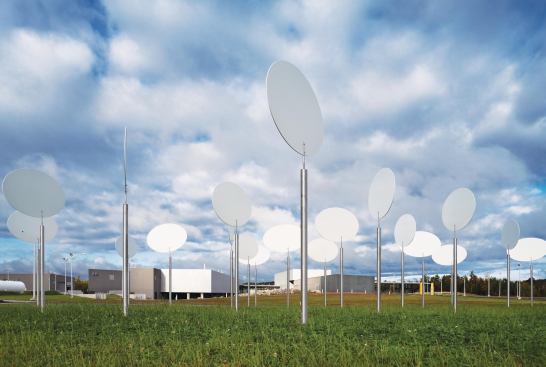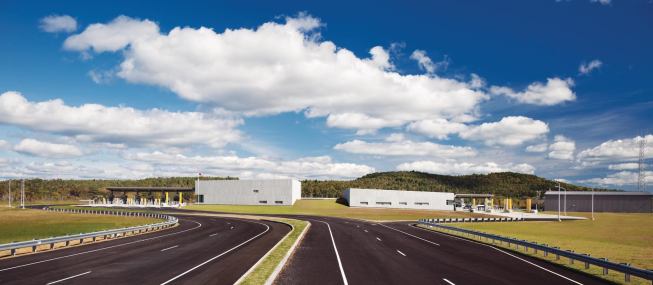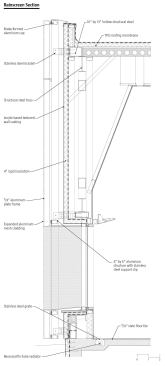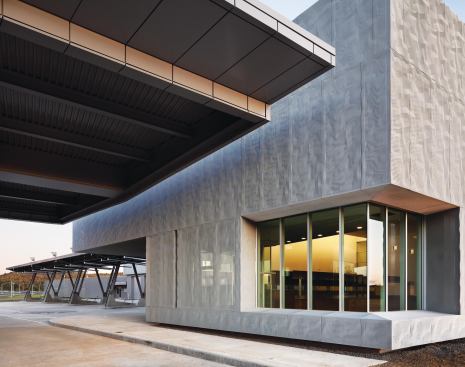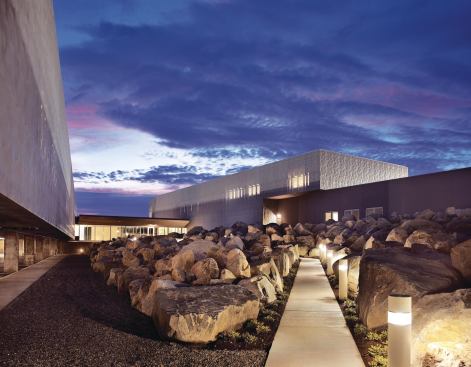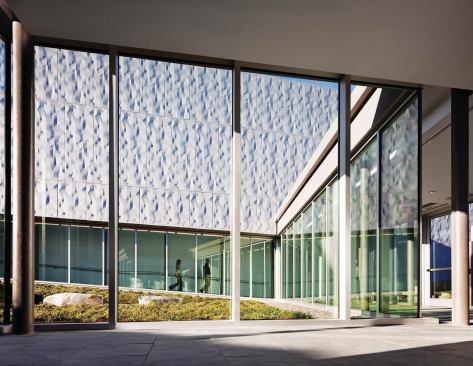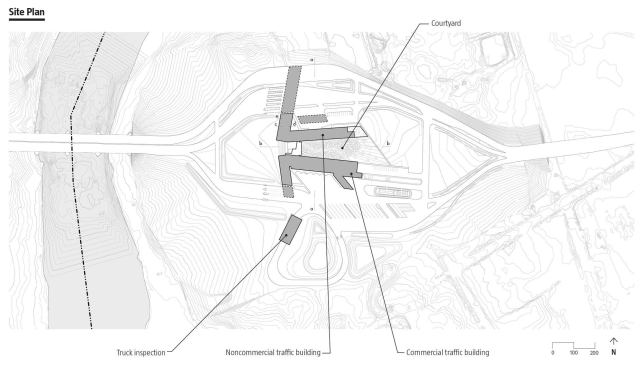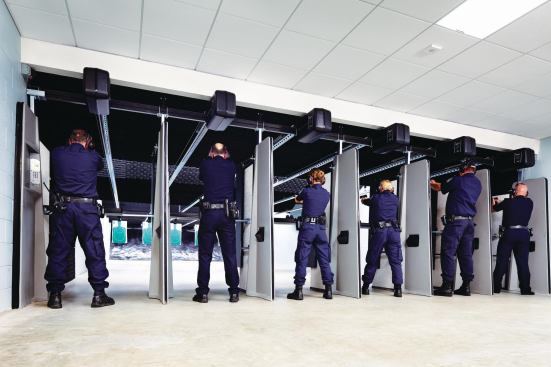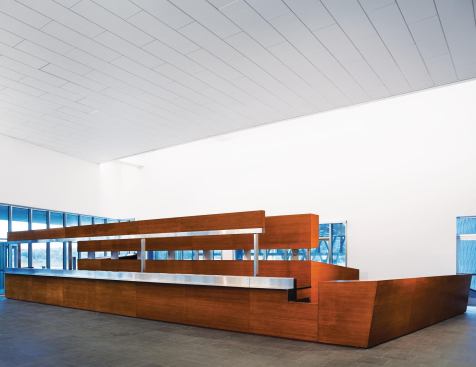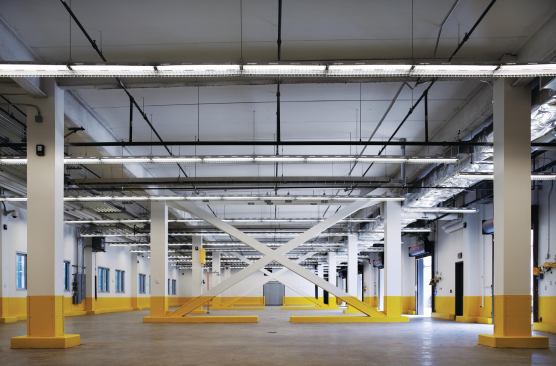Paul Warchol
U.S. Land Port of Entry in Calais, Maine.
When architect Robert Siegel received the commission to design the United States Land Port of Entry in Calais, Maine, the easternmost border crossing between the U.S. and Canada, he didn’t instantly start sketching—he went on a road trip. In the middle of winter, Siegel and project manager Eduardo Ramos left their New York office, jumped in the car and visited more than 20 border-control stations in the Northeast. Driving back and forth between the two nations was revealing, even as it raised a few patrol officers’ eyebrows. The architecture at each crossing was universally banal, if not downright off-putting: acres of asphalt, bad signage, and antiquated and undistinguished buildings. Not exactly a warm welcome to the United States.
Siegel’s field research led to a 100,000-square-foot facility designed as a gateway for the car and truck traffic that flows into New England. As part of the U.S. General Services Administration’s Design Excellence Program, the border crossing has to strike a careful balance between being inviting and answering the security needs of the Department of Homeland Security’s U.S. Customs and Border Protection.
Project Credits / Materials & Sources
Project Credits
Project United States Land Port of Entry in Calais, Maine
Client/Owner United States General Services Administration
Architect Robert Siegel Architects, New York—Robert Siegel (principal, lead designer); Eduardo Ramos, Richard Tobias (project managers); Brad Burns, Julien Leyssene, Wayne Walker, Holly Williams, Heather Pfi ster, Justin Huang, Fatmir Hodzic, Kelsey Yates (project team)
Mechanical/Electrical/Structural/Civil Engineer/Lighting Designer Arup
Construction Manager Coast and Harbor
General Contractor J&J Contractors
Landscape Architect Sasaki Associates
Façade Consultant Front
Size 100,000 square feet
Cost $53 million
Materials & Sources
Acoustics: Sonex sonexfoam.com
Adhesives, Coatings, and Sealants: DowCorning dowcorning.com, Tremco tremcosealants.com, Roberts Consolidated Industries robertsconsolidated.com
Ceilings: CertainTeed Corp. certainteed.com, Armstrong armstrong.com, Globalnex globalnex.com
Concrete: Lafarge North America lafargenorthamerica.com
Exterior Wall Systems: Sto Corp. stocorp.com, MG McGrath mcgrathshtmtl.com
Flooring: Sheldon Slate Products Co. sheldonslate.com
Furniture: Knoll knoll.com
Glass: Oldcastle Glass oldcastleglass.com, Solar Seal Co. solarseal.com
HVAC: RTH Mechanical Contractors, York by Johnson Controls york.com
Insulation: Knauf Insulation knaufusa.com, Roxul roxul.com, Isolatek International isolatek.com
Lighting Controls: Lutron Electronics lutron.com
Lighting: Bega bega-us.com, Cooper Lighting cooperlighting.com, Elliptipar elliptipar.com, Zumtobel zumtobel.us, Luminaire Lighting Corp. luminairelighting.com, RLE Industries rleindustries.com, Guth guth.com
Masonry and Stone: J & B Granite Works jbgranite.com
Metal: Cianbro cianbro.com
Paints: Sherwin Williams sherwin-williams.com
Plumbing and Water System: RTH Mechanical Contractors, Eljer eljer.com, Chicago Faucets chicagofaucets.com
Roofing: Carlisle SynTec carlisle-syntec.com
Site Products: ACF Environmental acfenvironmental.com, GSE Lining Technology gseworld.com
Walls: Panelfold panelfold.com
Seen from the highway, the Land Port of Entry’s two low-slung buildings frame a slice of the Maine landscape. Approaching the facility, commercial traffic veers right, where the checkpoint structure is equipped with warehouses big enough to off-load and inspect truck cargo. The left lanes process noncommercial (car and bus) traffic. And while most cars that pass under the large steel canopies get quickly waved through border patrol on primary inspection, some are stopped and the drivers brought into interview rooms for additional questioning and a secondary inspection. A secure detention area is available in the event of a worst-case scenario. (And there’s even a firing range for officer training.) A walkway, tucked out of the public’s view, allows officers to pass between the commercial and noncommercial wings.
The facility is on track for LEED Gold certification, and many of its sustainable features come from attention to the landscape. It sits on top of an aquifer that feeds the nearby town, so bioswales were used to naturally filter runoff back into the water table. Additionally, the design team took care to reduce the amount of asphalt used across the site.
Although an exacting program, environmental constraints, and operational needs drive the buildings’ layouts, a poetic understanding of the landscape inspired Siegel’s scheme. “We looked to the site’s history—it was formed by glaciers scraping across the land. I see cars passing through the border, carving through the landscape, as the modern-day version of the glacier,” he says. A courtyard between the two structures represents that geologic influence quite literally: It’s filled with chunks of granite excavated during construction, repurposed into an artificial moraine—the rock debris left in the wake of a glacier.
Siegel’s fascination with the boulders’ textures also influenced the design of the metal rainscreen that wraps the two buildings. Each 10-foot-tall and 40-inch-wide expanded-aluminum mesh panel is patterned to look like granite. “We created a drawing that has the same gestalt as a rock,” Siegel explains. “Then we made a 3D model of it, creating valleys and ridges.” More than decorative, the metal skin creates a layer of security. When sunlight hits the façade, the mesh appears solid, but ample daylight reaches the interior. The aluminum panels conceal windows cut into the basic stucco walls beneath so that officers on the inside of the buildings can survey all activity, but the public cannot see in. Like many aspects of the Land Port of Entry’s design, the metal screen reveals the tension between the buildings’ two objectives: to be welcoming and to be safe.
